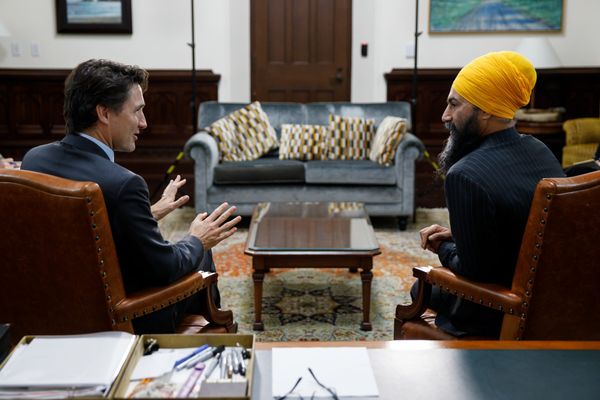COVID-19 is laying bare the myths of value, meritocracy and equality of opportunity that underwrite wage inequities in the capitalist market. While critics have seen through the apparatus that produces inequality and justifies it after the fact as natural, necessary and even good, capitalism has been resilient to — and prone to building upon — shocks, crashes, recessions and depressions. But now, something may be changing.
This crisis, uninvited and unwelcome, has brought into focus the stories we tell ourselves about who deserves what, and why. As the world struggles to manage COVID-19, casting furtive looks ahead into the post-pandemic world, now is the time to revisit these myths, to double-check these stories and to reassess how we value labour — and how, accordingly, we think about, care for and compensate workers. We have reached a critical juncture, and we must choose a new way forward.
Inequality in compensation isn’t new, but in recent years it has transformed into a grotesque leviathan. A look at chief executive officer pay compared to workers offers a case study in extremes.
In 2018, corporations in the United States released CEO earnings data. The AFL-CIO crunched the numbers and found that the “CEOs of S&P 500 companies received, on average, $14.5 million in total compensation.” On the face of it, the sum is obscene. Compared to what the average employee makes, it’s worse, as the labour union federation also determined that “the average S&P 500 company CEO-to-worker pay ratio was 287 to 1.” The Economic Policy Institute (EPI) reports CEO pay to have jumped by 1007 per cent between 1978 and 2018, compared to a 12 per cent increase for workers during those years.
In Canada, the numbers are no less discouraging. In 2020, the Canadian Centre for Policy Alternatives released a report showing that in 2018, CEOs made 227 times more than the average worker. The author of the study, David Macdonald, noted that “by 10:09 a.m. on January 2, the average top CEOs will have made as much money as the average Canadian worker will make all year. That’s the earliest time on record in the 13 years we’ve been tracking these numbers.”
In a 2019 essay for Time Magazine, headlined “Why CEOs Actually Deserve Their Gazillion-Dollar Salaries,” economics professor Tyler Cowen defended astronomical compensation. Cowen argued that “CEO pay is largely caused by intense competition.” He reasons that competition, based on skills, availability and performance, account for salaries along the usual highways and byways of supply and demand. “It’s not popular to say,” Cowen writes, “but one reason their pay has gone up so much is that CEOs really have upped their game relative to many other workers in the U.S. economy.”
Chief executives work hard, manage a lot and bring a rare skill set and expertise to their work — that’s the argument. However, nowhere in this or any other argument that I’m aware of do we find a compelling justification for that “upping” leading to a ratio of nearly 287 to 1 in the U.S., or 227 to 1 in Canada, between CEOs and workers. I think I know why.
In the U.S., hourly compensation hasn’t tracked with worker productivity increases since the 1970s. According to the EPI, “From 1979 to 2018, net productivity rose 69.6 per cent, while the hourly pay of typical workers essentially stagnated — increasing only 11.6 per cent over 39 years (after adjusting for inflation). This means that although Americans are working more productively than ever, the fruits of their labors have primarily accrued to those at the top and to corporate profits, especially in recent years.”
Divergent productivity, skills and extreme inequality in compensation isn’t the natural order of things — it’s the product of power and politics. It’s the outcome of choices made — and not made — by companies and states, buttressed by popular narratives.
While competition and skills account for some of the discrepancy in pay rates between executives and workers, our conceptions of merit themselves are based on a system that produces winners and losers within a set of rules, which is political. This is a system that creates and sustains myths to support itself and to validate extraordinary inequality based on the fable of equal opportunity, despite the fact that so many of its players start the match on their knees, with both hands tied behind their back. In other words, once more, economic systems are about power, not nature.
Cowen’s argument — which is the standard defence of high CEO compensation and inequality — assumes that the mechanics of the system are given and invariable, closer as a phenomenon to gravity than the rules of a board game or sport. But who says it must be this way? The rules could be different. Public policy could be different. Conceptions of values could be different. Exorbitant executive pay is a construct. It can be deconstructed. It ought to be.
Taking a different perspective, “competition” for CEO positions and the wage inflation that follows can be seen as an instance of solidarity and an expression of the capacity of a powerful few to mould the world by shaping systems and the narratives that support them. Not all of these efforts are directly coordinated, but they’re connected by class interest and embedded in a self-sustaining, indeed a self-growing, culture of greed and entitlement.
Some say it’s “competition” that drives up the cost of chief executives, but if the norm and expectations were different, competition could lead to altered salary demands. If, for instance, CEO candidates were told, across the board, that no one could make more than $2 million a year — or, say, more than five times the salary of their lowest-paid worker — then compensation packages would be negotiated within that range. But that doesn’t happen, because the norm of eight-figure salaries is accepted in the corporate culture, and CEOs — as well as those working hard to join them — are complicit, even as they tell workers their value is lower and fixed as such. The norm isn’t merely about supply and demand, but rather about having the power and resources to dictate terms.
Yet the system that produces extraordinary differences in compensation is neither organic nor inevitable. It’s a function of class solidarity among the wealthy and powerful, backed by state policy made within a globalized economic system in which capital is fluid and the threat of its flight hangs over us all. Natural indeed.
Imagine if greater class solidarity and state backing was extended to workers, especially those who are marginalized. What would happen to their salaries then?
Would front line employees be risking their lives to stock shelves or clean hospitals during a pandemic for $12 to $15 an hour? (During the pandemic, several retailers in dire need of workers in the U.S. and Canada have temporarily raised wages a few dollars per hour and offered bonuses.)
In such a world, would conceptions of value lead us to conclude that a suit in a C-Suite office is worth nearly 300 times a worker whose labour is essential to, for instance, our survival during a pandemic?
Of course not.
As the history of labour union movements teaches us, when workers organize and aren’t impeded by bosses, executives and governments, they’re better treated and compensated. It’s no coincidence that the runaway rise of executive compensation tracks with the decline of the state, drops in the rate of unionization, the political project of neoliberalism, upsurges in deregulation and the era of consolidated corporate power that began in earnest in the 1970s and has continued apace ever since. The current course of events is neither desirable nor sustainable.
COVID-19 has ushered in a moment in which a reset is possible. Executives may be necessary within the current system, but as workers risk their lives to keep others fed, sheltered, medicated, safe and alive by driving trucks, producing food, stocking shelves, cleaning buildings, manufacturing equipment, cooking meals, delivering goods door to door, and more, we’re reminded that their work is essential and valuable. This was true before the pandemic and it will be so after — at least if we wish to continue to live, more or less, the sorts of lives we lived before.
In the short term, countries and businesses must protect their workers and compensate them fairly. Some of the resources necessary for that endeavour can and should come from the pockets of CEOs. Cut their pay; slash it to the bone. Change the rules of the game. Rewrite the myths. Support unions and grow their numbers. If executives don’t like it, they can organize a caravan to Galt’s Gulch. We’ll replace them soon and well enough.
The post-pandemic world ought to be one in which labour freely offers its cooperation based on a deal that recognizes the necessity and value of all work, seen and unseen. The effort to bring about that world will take years, but it’s necessary. When the effort is complete, however, we will have a system that is not only more just and decent, but also better prepared for future crises.






